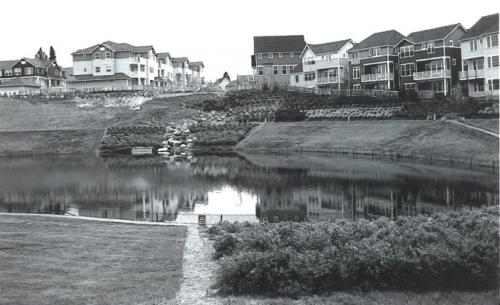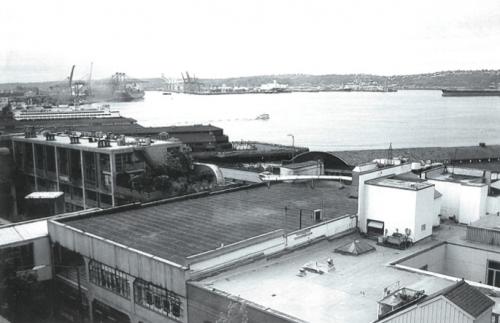Like San Francisco, Seattle is a city constrained by geography and its proximity to water. It also confronts similar challenges in neighborhood planning, the potential conflicts between residential and industrial uses and the greening of the city. How does Seattle do it?
More flashy than Portland, less dressed up (and yet less disheveled) than San Francisco, Seattle is in many ways a big city caught in the mindset ofa small town. Much like San Francisco, Seattle is a city defined by its geography. Its neighborhoods are set apart by water, topography and massive infrastructure — from the city's hourglass shape that funnels everyone and everything movingnorth-south through the center city, to the east-west system of lakes and ship canals linking Lake Washington to Elliot Bay, to the sprawling industrial mudflats of the Duwamish River to the south. This fractured geography has been part of the city's DNA from the beginning. Seattle's founding families — Denny, Boren, and Maynard — laid out the downtown on three competing grids, each orienteddifferently to the crescent-shaped waterfront,foreclosing the possibility of a functional downtown street grid for generations to come, and setting the tone for a city planned through many small, incremental actions over time.
Seattle's planning challenges have to do with this city of small towns finding the common ground to tackle the fact that it has become a big city, with big-city problems. Seattle is very much an architect's city: It celebrates individual works of city building (the Olympic Sculpture Park, or Rem Koolhaas’ Central Library) and shies away from sweeping city plans, with the exception of the Olmsted Brothers’ 1903 Parks Plan. While Seattle has no shortage of big issues to solve — notablyits lack of a robust regional transit system and its deteriorating waterfront viaduct — there is not the same confidence in the potential for public planning to solve city problems.
That said, there are lessons, both bad and good, from Seattle's approach to planning that may be valuable to San Francisco.
1. “NEIGHBOR POWER" —BE CAREFUL WHAT YOU WISH FOR
Following outcry over upzoning and “unchecked density” associated with the city's 1994 Comprehensive Plan, the city initiated a massive new effort at neighborhood planning. As part of its Comprehensive Plan Update in 1999, the city gave grants for neighborhoods to hire their own staff and develop plans individually, and left its professionalcity-planning staff largely behind the permit counter.
What resulted was more than 38 neighborhood plans developed by more than 20,000 people — a monumental level of grassroots participation — but little ownership within government, and a lack of actionable thinking about land-use issues and growth issues.
These plans established a broad base of support for a round of successful library and parks bonds, and built a network of effective community stewardship boards that keep the plans alive. However, most of the tougher, more basic land use and transportation issues affecting these neighborhoods — height, density, public benefits, how to better manage increasing congestion — were left largely unanswered.
Today, frustration with these shortcomings led to a renewed push for neighborhood planning. At issue, however, is the role that the city planning department will play. The mayor has proposed that the city's Department of Planning and Development lead the effort working with neighborhoods,but many members of the community and the City Council object. A recent headline from my neighborhood newspaper, the West Seattle Herald, cautions in 60-point type, “Planning May Shift Downtown: The city wants to take the lead this time as it decides how West Seattle should update its neighborhood plans." Because the city wasn't at the table the first time, there is a lot of work to do to convince people of the value that city planners can bring to the neighborhood.
High Point, a HOPE VI development, makes use of a retention pond to manage its stormwater.
2. INDUSTRIAL LANDS — A BALANCED APPROACH
Twelve percent of Seattle's land area is in whatwe traditionally think of as industrial uses: manufacturing, distribution, repair and maritime-related activities. It is important to keep in mind that Seattle's economy is very different from San Francisco's. The Port of Seattle is a major forcein the U.S. economy and generates a substantial amount of spin-off business. Seattle's industrial businesses are responsible for a whopping 25 percent of the city's employment, and vacancy rates for industrial space fluctuate between 3 percent and 5 percent. The city's industrial uses are thriving. Still, development pressure is mounting on the areas immediately south of the downtown. The speculative real estate market has bet that the city will rezone the south downtown and has driven up land prices by nearly 200 percent.
Seattle is dealing with this in two ways. First, over the past year, the Planning Commission has developed a citywide industrial-lands strategy. This strategy proposes immediate action to set aside industrial areas with the most valuable infrastructure and stock of industrial space, and to prohibit residential and large-scale commercial uses where they would compete for land with industrialusers. More importantly, it is timed to coincide with upzonings in South Lake Union, Pioneer Square, Chinatown and the International District. These areas will not only provide a release valve for development pressures, but also will do so in close proximity to the downtown, where parks, streetcar service and other amenities needed to create complete neighborhoods can be provided efficiently. Without a balanced strategy, Seattle realized that residential and commercial development would sprawl scattershot across the industrial lands as sites became available, and the city would likely not only undermine its base of well-paying industrial jobs, but also would end up with scattered residential enclaves lacking the amenities to serve this new population. Sound familiar?
In addition to traditional regulatory approaches, Seattle invests proactively in creating new industrial space, attracting growing industrial businesses to key locations and providing them with the resources to grow their employment base. This is no small task. It requires intensive cooperation among the Office of Economic Development, the Department of Planning and Development, and the Port of Seattle, which is by far the city's largest industrial landowner. In the lnterbay Manufacturing/Industrial Center, the city is adopting a new strategy to simultaneously allow 1.2 million square feet ofnew office uses on Port land, in exchange forthe development of more than 350,000 square feet of new, permanent industrial space. Theport is negotiating a long-term lease with KORRY Electronics, a long-time supplier to Boeing, which will relocate from upzoned lands in South Lake Union to this site, and anticipates expanding from 600 employees to more than 1,000 once in this new industrial space.
The Port of Seattle is a major national economic force and the city’s largest industrial landowner.
3. GREEN — BEYOND THE BUILDING
While the city has no shortage of green roofs and flowerbaskets, Seattle goes farther in bringing green strategies to the practice of local government. As Steve Moddemeyer describes elsewhere in this edition of the Urbanist, Seattle is in the process of redefining the way it manages a range of public assets — utilities and drainage systems, roadways, even parks — to maximize their potential as ecological infrastructure. The city's potable andwastewater facility, Seattle Public Utilities, has created a program to consider a range of project alternatives for each capital improvement, factoring in not only the capital cost, but also the long-term maintenance and operations costs. This “life cycle” approach to managing public infrastructure has led Seattle Public Utilities to initiate demonstration “green infrastructure” projects across the city. These projects range from vegetated swales on quiet suburban streets, to raingardens in the heavily-trafficked downtown, to an entire HOPE VI redevelopment, High Point, designed to manage stormwater on-site through the use of pervious surface areas, green streets, and a stormwater-retention pond that doubles as an for the amenity neighborhood.
These initial demonstration projects are convincing many people in City Hall that lifecycle thinking should be applied to the city's entire Capital Improvement Plan — enabling “green” infrastructure strategies to replace the conventional “gray" infrastructure of pipes and pumps, at a lower overall cost to the city.